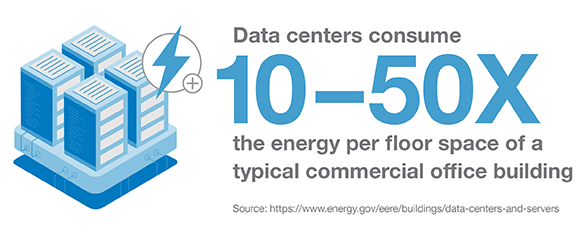- myLubrizol
-
-
Search Immersion Cooling
Growing demand for digital services continues worldwide, spurring the continued proliferation of more and more powerful hyperscale data centers. The International Energy Agency (IEA) estimates that “the number of internet users worldwide has more than doubled since 2010, while global internet traffic has expanded 20-fold.”
With that growth has come an increasingly pressing need to evaluate the ecological impact of such massive data infrastructure. According to the United States Office of Energy Efficiency & Renewable Energy, data centers are one of the most energy-intensive building types—they often consume 10 to 50 times the energy per floor space of a typical commercial office building. Further, the IEA reports that data centers and transmission networks are responsible for nearly one percent of all energy-related greenhouse gas emissions.

It follows, then, that data center emissions and power consumption are coming under greater regulatory scrutiny. For example, as of 2023, the European Commission’s Energy Efficiency Directive (EED) will require data centers in the European Union “with an installed IT power demand of at least 100 kilowatts to publicly report their energy performance yearly,” according to Data Center Knowledge. Key metrics will include power, water, and carbon usage effectiveness; energy reuse factor; renewable energy use; cooling effectiveness ratio; and more.
The time is now for data centers to proactively evaluate the efficiency of their operations. One area of opportunity—and increasing urgency—is cooling systems for more and more powerful servers. As power increases, so does generated heat, meaning heating, ventilation and cooling (HVAC) systems must use more power to compensate. But even that may not be enough, as the escalating scale of modern data centers has begun to render traditional air cooling methods not just inefficient, but ineffective.
One increasingly mature cooling method has major potential: immersion cooling, in which hardware is submerged in dielectric fluid. It’s a practical option for overcoming heat issues, with notable energy-saving benefits when compared to traditional HVAC setups.
In immersion cooling applications, all computer components are submerged in nonconducting fluids, which transfer heat from the equipment much more efficiently than cool air.
Both single-phase and two-phase immersion cooling configurations exist. In single-phase immersion cooling, hardware is submerged in a dielectric fluid that makes direct contact with the IT equipment, conducting heat away as the fluid flows through a heat rejection mechanism, typically operated with facility water. In two-phase cooling, a fluorocarbon-based fluid readily boils when in contact with equipment hot spots, transitioning the fluid from a liquid to a vapor that is condensed and recirculated into the cooling tank.
Both configurations offer superior energy efficiency, increased compute density, and improved cooling characteristics versus conventional systems. Benefits include:
It’s worth noting that single-phase systems present a few unique advantages versus two-phase. First, there is significant potential to tailor the fluid in a single-phase system, creating an opportunity for solutions that meet the needs of future hardware. Single-phase immersion cooling solutions can also further reduce carbon emissions, positively affect energy consumption, and more. And there is even greater potential ahead: Immersion cooling systems may soon be able to contribute to heat recapture and energy reuse, possibilities that could one day power data centers themselves or even nearby communities.
CompuZol™ immersion cooling fluid solutions from Lubrizol help data centers address their energy consumption while delivering greater computing power, enabling more sustainable and successful operation. Contact your Lubrizol representative to find out how CompuZol can transform your data center operations today.